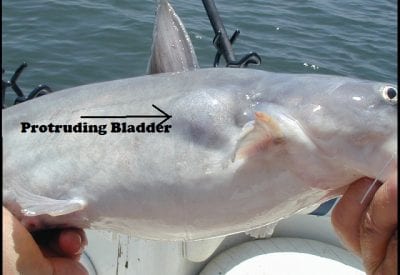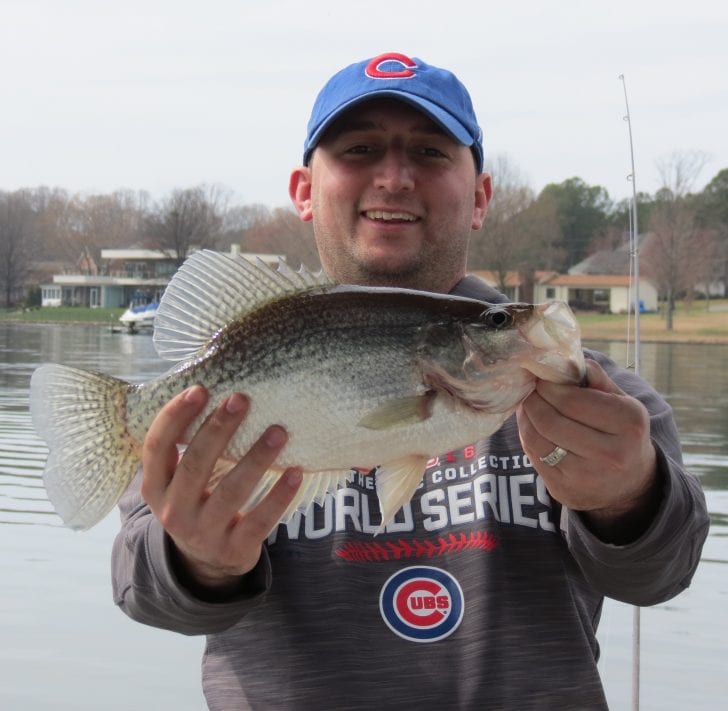By Jake Bussolini
We are all aware of how the weather affects our fishing habits but that knowledge usually involves temperature, sunlight, rain, snow etc. During the early Spring months there is another weather element that is killing a large number of our prized freshwater fish. That killer is called “barotrauma”. Most freshwater anglers believe that this problem is generally limited to ocean fishing where fish are rapidly brought up from very deep depths. What many of these fish witness is what we have all grown to know as “the bends,” also experienced by divers who come to the surface from deep waters too rapidly.
Most freshwater fish have a swim bladder that helps the buoyancy of the fish as it changes depths. In a few species, this bladder is connected directly to their gut which permits those fish to burp out air as they ascend toward the surface. Many other freshwater species have no connection between the two organs and they are very susceptible to the problem.
How does this become a weather problem you ask? In this region of the country there are often rapid large temperature changes between winter and spring. When the winter water cools rapidly, the fish all head for the deeper water where it is slightly warmer and they stay there until they are convinced that the water has warmed as spring approaches. During these periods the fish may go as deep a 30 to 50 feet. At those depths, the hydrostatic pressure on the body of the fish caused their swim bladder to compress. If fish at these depths are suddenly pulled rapidly to the surface, the bladder expands to enormous sizes, causing all kinds of problems for the fish. The most noticeable effect of this problem is that if the fish are unhooked and thrown back into the water, they appear to be dead and they cannot swim back down to relieve the problem. They will float on the surface for a few minutes until they die. If the fish can be sent quickly back down below 30 feet within about two minutes, they can naturally re-compress and go on with their normal life. But how can an angler get that fish back down to that depth? That’s the real problem.
I have witnessed this problem several times. My first experience was at Santee Cooper Lake where I caught a 20 pound blue catfish in about 50 feet of water. When the fish was taken out of the net, it was obvious that there was a problem. (see the photo below)
The swim bladder had expanded and was visible as shown. The Captain was experienced with this problem and had a small piece of garden hose that he inserted into the throat of the fish permitting the air to escape. The fish was returned to the water in fine condition.
I have witnessed the problem in Lake Norman several times in recent years with crappie. This species seems very susceptible to this problem. Last week I was fishing with my Grandson. We were not fishing for crappie but in 40 feet of water he caught a nice 13 in. fish shown below. He retrieved the fish as he would retrieve a bass, very quickly.
Since this was his first crappie he wanted a photo so we took the time to get this picture. The fish looked very healthy but we were not interested in eating it and it was returned to the lake. The fish made a couple of movements but simply floated on the surface. It had the bends and was not going to survive. We recovered the fish and it was going to make him a fine meal.
I have seen this problem several times on Lake Norman and I keep two hypodermic needles on my boat. If a needle is inserted into the fish just behind the pectoral fin, it can often provide an escape path for the trapped air. This process is called “fizzing”. This process can sometime cause other problems with the fish however I feel that if the fish is going to die, why not give it a chance for life. The process has worked for me on other occasions.
There are other devices available called descending devices that can send the fish down below 15 feet very quickly. Commercial anglers sometimes have these devices on their boats on the ocean waters but they are rarely available to freshwater anglers.
North Carolina anglers should understand that lakes such as Lake Norman have waters as deep as 100 feet. Fish are rarely that deep but they will go to 50 feet if the water temperature and oxygen at that depth is comfortable to them. Bringing a fish up rapidly from that depth can and will cause problems, especially with crappie.
Jake Bussolini is a freelance writer who has written several books about freshwater fishing. His books can be seen at www.booksbyjake.com.
Jake Bussolini – Writes about The Science of Fishing
www.booksbyjake.com
Jake has spent the last 20 years re-directing his life’s efforts toward sharing his knowledge and fishing experiences with others. As the author of several books about freshwater fishing, Jake has taken the unusual route of investigating the science behind the sport. His books and other writings offer the unique opportunity to understand the strategies for catching more and bigger fish, while attempting to provide the scientific facts that control the behavior of the fish and their natural surroundings.


